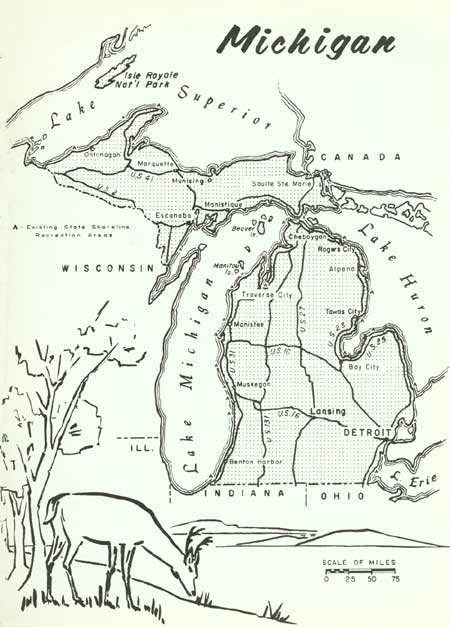|
NATIONAL PARK SERVICE
Great Lakes Shoreline Recreation Area Survey |

|
REMAINING OPPORTUNITIES IN MICHIGAN

|
| Michigan (State Map) (click on image for an enlargement in a new window) |
OVERALL SUMMARY
Though Michigan's 3,200-mile shoreline lost to Alaska its distinction as the longest in the United States, its scenic charm and beauty as a water wonderland cannot be challenged. Encompassing parts of Lakes Erie, Huron, Michigan and Superior, the shores follow the infinite variety of marsh, sand, cobble and rocky headland.
The Great Lakes have not only been responsible for fashioning Michigan's scenic heritage, but they have also influenced the discovery and development of a huge inland empire. The search for the Western Sea brought the white man to the lakes' shores, while later the quest for fur rekindled his interest to push farther into the frontier. The passing of the fur trade found the fur-laden canoe supplanted by the ore and grain freighters. Today, a new horizon is opening over the Great Lakes--soon to be the world's eighth sea. Detroit and other cities on the Great Lakes will take their place among the ports of call for ocean-going vessels. The promise of this new era by the St. Lawrence Seaway has eclipsed in many respects a second significant achievement on the Great Lakes--the opening of the Straits of Mackinac Bridge in November 1957.

Long separated as two relatively isolated regions, the Upper and Lower Peninsulas are now only ten minutes apart by automobile. The feeling of remoteness associated with Lake Superior and northern Lakes Michigan and Huron will one day disappear as improved access becomes more common. When this atmosphere is gone, something else will probably have disappeared also--undeveloped shoreline. But today an opportunity still remains to set aside outstanding shore features for public benefit.
The history of conservation has all too often been written in the tone of "too little, too late." Already the populated regions of southern Michigan have proven this, and it is only as we move north that the opportunities for public shoreline increase. The culmination of undeveloped shoreline resources is found in the vastness of the Upper Peninsula. But, with our society geared to a jet age and the era of "count downs" virtually upon us, the many undeveloped resources of today may be only ephemeral situations.
This is the challenge that faces Michigan. The Upper Peninsula presents an opportunity for the study of a recreation land use plan unhampered by many conflicting uses. This same opportunity no longer exists on the Lower Peninsula where many uses have gained control and others seek to eliminate additional shoreline from public use.
During the course of this Survey, 13 areas with a combined shoreline of nearly 195 miles were selected on the Upper Peninsula. They represent not only some of the finest shore features of Michigan but of the Great Lakes as well. The scenic cliffs of the Pictured Rocks and the granite domes of the Huron Mountains represent superlative elements of the Great Lakes that should receive national recognition. The beaches and hinterlands of Seul Choix on the northern shores of Lake Michigan show promise as one of the outstanding state park possibilities along the Great Lakes.
On the Lower Peninsula, 27 shoreline sites with approximately 100 miles of shoreline were selected along Lakes Michigan, Huron, St. Clair and Erie, as well as the St. Clair and Detroit Rivers. Paramount among these areas was Lake Michigan's Sleeping Bear with its unusual scenic and natural values commanding attention as an equal to the Upper Peninsula's Pictured Rocks and Huron Mountains. However, often confined to limited frontages, many of the areas were found pinched between developments that threaten to completely engulf them. In some instances, recommendations involve existing state parks where additional area is necessary to adequately provide for growing public use and essential to protect significant park values. Also, from time to time some lands now in public ownership, principally held by the U. S. Coast Guard, are declared surplus to the needs of the administering agency. Frequently these sites occupy areas suitable for recreation or other conservation uses. No effort should be spared to retain them in public ownership, for such areas as Sturgeon and Tawas Points on Lake Huron have outstanding potential to meet public recreation needs.
With Michigan's command of the largest portion of the Great Lakes shoreline, it is natural that most of the undeveloped shore opportunities also occur here. Consequently, this situation is responsible for the tremendous scope of the problem of preserving an unspoiled shoreline for public use. The challenge of the problem must be met by all citizens, for in the final analysis it is by their action and support that the public's interest in the conservation of its shoreline can serve as a model for preserving a great natural heritage.

| <<< Previous | <<< Contents>>> | Next >>> |
rec_area_survey/gl/mi.htm
Last Updated: 27-Jun-2007